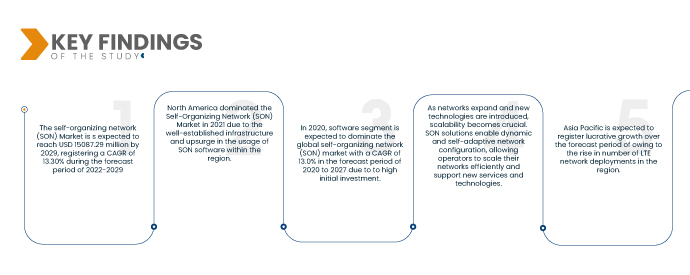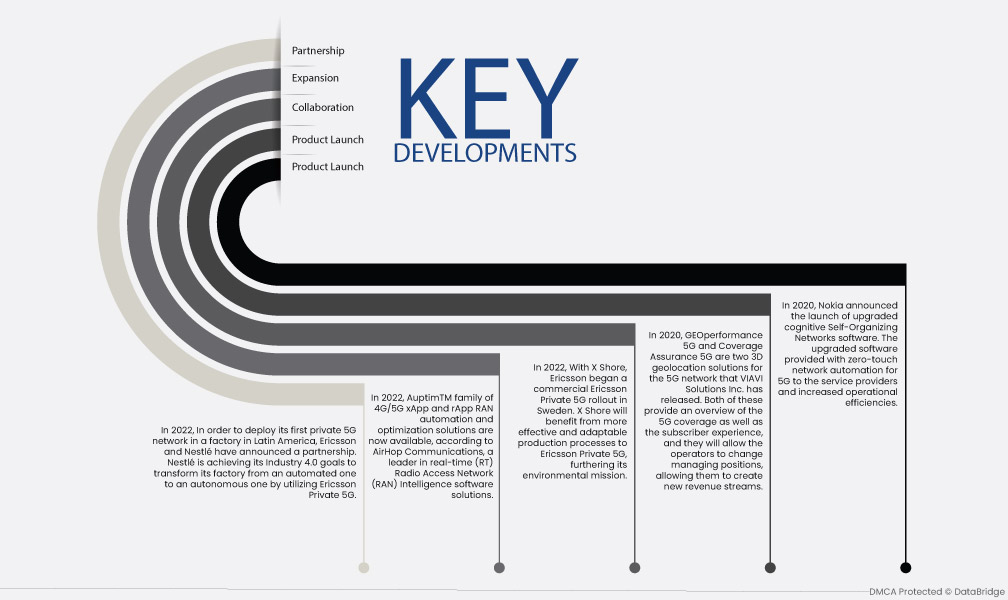Технология самоорганизующейся сети (SON) обеспечивает эффективное управление сетевым трафиком, что приводит к повышению удовлетворенности клиентов и эффективной балансировке нагрузки. Она упрощает управление сетями разных поставщиков за счет автоматизации процессов оптимизации. SON динамически настраивает параметры сети, оптимизирует распределение ресурсов и решает сетевые проблемы в режиме реального времени. Это оптимизирует операции, повышает производительность сети и обеспечивает бесперебойное подключение, что приводит к улучшению пользовательского опыта и повышению эффективности работы сетевых операторов.
Доступ к полному отчету по адресу https://www.databridgemarketresearch.com/reports/global-self-organizing-network-son-market
Data Bridge Market Research анализирует, что рынок самоорганизующихся сетей (SON) оценивался в 4 991,90 млн долларов США в 2021 году и, как ожидается, достигнет 1 5087,29 млн долларов США к 2029 году, регистрируя среднегодовой темп роста в 13,30% в прогнозируемый период 2022-2029 годов. С внедрением передовых технологий, таких как 5G, IoT и облачные вычисления, сложность сети значительно возросла. Решения SON обеспечивают автоматизированное управление и оптимизацию сети, помогая операторам сетей эффективно справляться с растущей сложностью.
Основные выводы исследования
Ожидается, что масштабируемость и гибкость сети будут определять темпы роста рынка.
Решения SON предлагают сетевым операторам возможность масштабировать и адаптировать свои сети к меняющимся требованиям. С помощью SON операторы могут легко распределять и оптимизировать сетевые ресурсы, обеспечивая эффективное использование и бесперебойное расширение. Это имеет решающее значение в динамических средах, где требования к сети меняются, позволяя операторам быстро реагировать на увеличение трафика, новые услуги или изменение пользовательских схем. Масштабируемость и гибкость, предоставляемые SON, позволяют операторам эффективно удовлетворять меняющиеся сетевые потребности.
Область отчета и сегментация рынка
Отчет Метрика
|
Подробности
|
Прогнозируемый период
|
2022-2029
|
Базовый год
|
2021
|
Исторические годы
|
2020 (Можно настроить на 2014-2019)
|
Количественные единицы
|
Доход в млн. долл. США, объемы в единицах, цены в долл. США
|
Охваченные сегменты
|
Предложение (ПО и услуги), Сеть (RAN, Wi-Fi, базовая сеть и транспортная сеть), Архитектура (C-SON (централизованная), D-SON (децентрализованная) и H-SON (гибридная)), Сетевые технологии (4G/LTE, 2G/3G и 5G), Приложение (сетевая безопасность и аутентификация, WAP, межмашинная связь, глобальная система позиционирования, игры и другие)
|
Страны, охваченные
|
U.S., Canada and Mexico in North America, Germany, France, U.K., Netherlands, Switzerland, Belgium, Russia, Italy, Spain, Turkey, Rest of Europe in Europe, China, Japan, India, South Korea, Singapore, Malaysia, Australia, Thailand, Indonesia, Philippines, Rest of Asia-Pacific (APAC) in the Asia-Pacific (APAC), Saudi Arabia, U.A.E, South Africa, Egypt, Israel, Rest of Middle East and Africa (MEA) as a part of Middle East and Africa (MEA), Brazil, Argentina and Rest of South America as part of South America.
|
Market Players Covered
|
Nokia (Finland), Cisco Systems, Inc. (U.S.), Telefonaktiebolaget Lm Ericsson (Sweden), Qualcomm Technologies Inc. (U.S.), Airspan Networks (U.S.), Innovile (Turkey), Corning Incorporated (U.S.), Hughes Systique Corporation (U.S.), Altran (France), Cellwize (Singapore), Airhop Communications (U.S.), ZTE Corporation (China), Comarch SA (Poland), P.I. Works (Turkey), CCS Ltd (India), Radisys (U.S.), VIAVI Solutions (U.S.) and Infovista (U.S.), among others
|
Data Points Covered in the Report
|
In addition to the insights on market scenarios such as market value, growth rate, segmentation, geographical coverage, and major players, the market reports curated by the Data Bridge Market Research also include in-depth expert analysis, geographically represented company-wise production and capacity, network layouts of distributors and partners, detailed and updated price trend analysis and deficit analysis of supply chain and demand.
|
Segment Analysis:
The self-organizing network (SON) market is segmented on the basis of offering, network, architecture, network technology and application.
- On the basis of offering, the global self-organizing network (SON) market has been segmented into software and services. The software segment is expected to dominate the global self-organizing network (SON) market with a CAGR of 13.0% in the forecast period of 2022 to 2029 due to to easy customization and integration with existing network infrastructure. Furthermore, scalability ensures efficient resource utilization and cost optimization for network operators.
- On the basis of network, the global self-organizing network (SON) market has been segmented into RAN, Wi-Fi, core network, and backhaul. The RAN segment is expected to dominate the global self-organizing network (SON) market with a CAGR of 12.6% in the forecast period of 2022 to 2029 due to the critical component of wireless communication networks, serving as the interface between mobile devices and the core network. It plays a crucial role in providing wireless coverage and connectivity to end-users.
In 2022, RAN segment is expected to dominate the network segment of the global self-organizing network (SON) market
In 2022, RAN segment is expected to dominate the global self-organizing network (SON) market owing to its increasing usage worldwide and critical component of wireless communication networks, serving as the interface between mobile devices and the core network. It plays a crucial role in providing wireless coverage and connectivity to end-users with the CAGR of 12.6% in the forecast period of 2022 to 2029
- On the basis of architecture, the global self-organizing network (SON) market has been segmented into C-SON (centralized), D-SON (decentralized) and H-SON (hybrid). C-SON (centralized) segment is expected to dominate the global self-organizing network (SON) market with a CAGR of 13.1% in the forecast period of 2022 to 2029 due to to combined advantages of C-SON (centralised) and D-SON (distributed) and it enables centralized control and management of the entire network infrastructure
- On the basis of network technology, the global self-organizing network (SON) market has been segmented into 4G/LTE, 2G/3G and 5G. 4G/LTE, 2G/3G, and 5G segments. 4G/LTE segment is expected to dominate the global self-organizing network (SON) market with a CAGR of 12.6% in the forecast period of 2022 to 2029 due to the future technology and adoption rate gaining pace.
- On the basis of application, the global self-organizing network (SON) market has been segmented into network security and authentication, WAP, intermachine communication, global positioning system, gaming and others. The network security and authentication segment is expected to dominate the global self-organizing network (SON) market with a CAGR of 13.7% in the forecast period of 2022 to 2029 due to rise of digitalization and the interconnectedness of networks, the risk of cyber threats and attacks has grown significantly.
In 2022 network security and authentication segment is expected to dominate the application segment of the global self-organizing network (SON) market
In 2022, network security and authentication segment is expected to dominate the global self-organizing network (SON) market owing to its network optimization properties suitable to wireless networks which is growing at rapid pace. Additionally, rise of digitalization and the interconnectedness of networks, the risk of cyber threats and attacks has grown significantly with a CAGR of 13.7% in the forecast period of 2022 to 2029
Major Players
Data Bridge Market Research recognizes the following companies as the major self-organizing network (SON) market players in self-organizing network (SON) Market are Nokia (Finland), Cisco Systems, Inc. (U.S.), Telefonaktiebolaget Lm Ericsson (Sweden), Qualcomm Technologies Inc. (U.S.), Airspan Networks (U.S.), Innovile (Turkey), Corning Incorporated (U.S.), Hughes Systique Corporation (U.S.), Altran (France), Cellwize (Singapore)
Market Development
- В 2022 году Ericsson и Nestlé объявили о партнерстве для развертывания своей первой частной сети 5G на фабрике в Латинской Америке. Nestlé достигает своих целей в рамках Индустрии 4.0 по преобразованию своей фабрики из автоматизированной в автономную, используя Ericsson Private 5G.
- По данным компании AirHop Communications, лидера в области программных решений для анализа сетей радиодоступа (RAN) в режиме реального времени, в 2022 году станет доступно семейство решений AuptimTM для автоматизации и оптимизации сетей радиодоступа 4G/5G xApp и rApp.
- В 2022 году компания Ericsson начала коммерческое развертывание Ericsson Private 5G в Швеции с помощью X Shore. X Shore получит выгоду от более эффективных и адаптируемых производственных процессов благодаря Ericsson Private 5G, что будет способствовать выполнению ее экологической миссии.
- В 2020 году компания VIAVI Solutions Inc. выпустила два решения 3D-геолокации для сети 5G: GEOperformance 5G и Coverage Assurance 5G. Оба решения предоставляют обзор покрытия 5G, а также опыта абонентов и позволят операторам менять позиции управления, что позволит им создавать новые источники дохода.
- В 2020 году Nokia объявила о запуске обновленного ПО для когнитивных самоорганизующихся сетей. Обновленное ПО обеспечило автоматизацию сети без вмешательства оператора для 5G для поставщиков услуг и повысило эффективность работы. Новое ПО позволило компании обеспечить лучшее качество и надежность сети для клиентов.
Региональный анализ
Географически в отчете о рынке самоорганизующихся сетей (SON) охвачены следующие страны: США, Канада и Мексика в Северной Америке, Германия, Франция, Великобритания, Нидерланды, Швейцария, Бельгия, Россия, Италия, Испания, Турция, остальные страны Европы в Европе, Китай, Япония, Индия, Южная Корея, Сингапур, Малайзия, Австралия, Таиланд, Индонезия, Филиппины, остальные страны Азиатско-Тихоокеанского региона (APAC) в Азиатско-Тихоокеанском регионе (APAC), Саудовская Аравия, ОАЭ, Южная Африка, Египет, Израиль, остальные страны Ближнего Востока и Африки (MEA) как часть Ближнего Востока и Африки (MEA), Бразилия, Аргентина и остальные страны Южной Америки как часть Южной Америки.
Согласно анализу Data Bridge Market Research:
Северная Америка будет доминирующим регионом на рынке самоорганизующихся сетей (SON) в прогнозируемый период 2022-2029 гг.
Северная Америка занимает доминирующее положение на рынке самоорганизующихся сетей (SON) благодаря региону, который может похвастаться хорошо налаженной телекоммуникационной инфраструктурой, обеспечивающей прочную основу для внедрения систем SON. Кроме того, в Северной Америке наблюдается значительный рост внедрения программного обеспечения SON, что обусловлено необходимостью оптимизации производительности сети, снижения эксплуатационных расходов и улучшения качества обслуживания клиентов.
По оценкам, Азиатско-Тихоокеанский регион станет самым быстрорастущим регионом на рынке самоорганизующихся сетей (SON) в прогнозируемый период 2022–2029 гг.
Ожидается, что Азиатско-Тихоокеанский регион будет расти в течение прогнозируемого периода из-за расширения сетей LTE, улучшающих связь, скорость передачи данных и покрытие сети в регионе. Кроме того, рост внедрения LTE способствует цифровой трансформации, поддерживает новые технологии и вносит вклад в общий рост телекоммуникационной отрасли Азиатско-Тихоокеанского региона.
Более подробную информацию об отчете о рынке самоорганизующихся сетей (SON) можно получить здесь – https://www.databridgemarketresearch.com/reports/global-self-organizing-network-son-market












